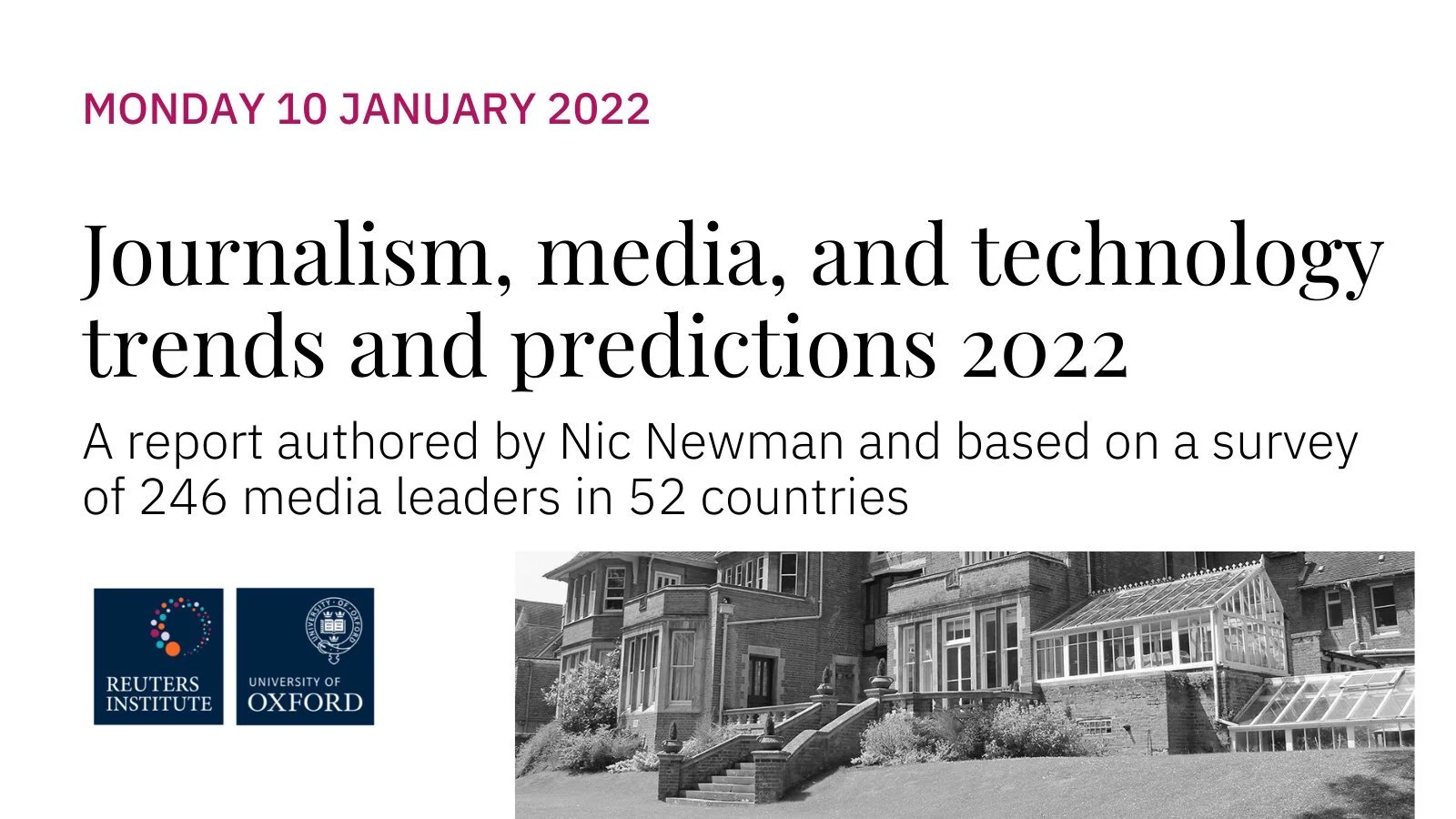My view of RISJ's Journalism, Media, and Technology Trends and Predictions 2022
Journalism and the news and media world has been challenged and disrupted. What we have seen from the past year is the slow drip-drip-drip of both how people have shifted their news consumption to social and digital platforms and the rise of ‘influencers’ that have learnt how to game algorithms of these platforms to retain and monetise their communities. Media outlets have either ignored the signs or just been too slow to pivot their content and storytelling to meet the changes in how people consume news and wider content.
Today’s sees the release of the Reuters Institute for the Study of Journalism’s ‘ Journalism, Media, and Technology Trends and Predictions for 2022’ report.
Written by Nic Newman, this years report interviewed 246 executives from 52 countries from around the world.
So, what can we take from this year’s report? Well, that once again we find the news and media industry at a crossroads, I’d say at the edge of a precipice even. For the last number of years, the essential disciplines of journalism and fact-checking have been losing the battle to keep audiences informed of facts. People have been and are continuing to pivot to online, social and messaging platforms and apps for their news.
The content and ‘creator economy’ has hooked many people into their communities and the messaging that they promote. Why? Simple really, they are just better at developing short-form content for time-poor people.
One of the key outtakes from this year’s report is about how non-media platforms and communities that have been pulling people away from traditional outlets have been better and more nimble at meeting the needs of audiences. For a variety of reason’s traditional outlets have been slow. Maybe they have just been in a bubble, needing to appeal to other influencers in their industry rather than the audiences that they are there to service and even, shock-horror, monetise from.
If you work in communications and public relations, there are some key aspects that you need to know about. I’m going to list ten that stand out for me.
Don’t just know your audience and the platforms that they use. Get to understand how they use these platforms and how and who shapes their views. User research is going to be critical in how you not such get your message across, but how you get buy-in.
Ignore media and journalism at your peril. The narrative for a good number of years is that you can bypass traditional media. You can’t. If you want to influence policy then remember who influencers policy-makers.
Plan your campaign with quality content and story-telling. But remember that to influence you need high-quality short-form content. With so much content around, audiences lose attention quickly and move on to something else. So plan your campaign with a story with content packages that you can drip out to keep audiences you want to influence engaged.
Content format is going to be key. But the problem that many will have is that to make it work they need their communications teams to be less rigid. Audiences flock to influencers because of their ability to tell a story, to make content relevant and engaging.
Over-marketed ‘all is good’ content will fail. Why? Because audiences out there of fact-checkers will quickly unpick all your nice glossy words and images. So be honest and transparent. Get your facts right and don’t over-sell.
Think of your content and your story-telling not just from your brand, but the stakeholders that help you deliver your products and/or services. Create a community, not just for your audience, but for the smaller SMEs that enable you to deliver your products or services. As an example, Arsenal Football Club has been running a great campaign promoting local businesses impacted by the pandemic.
Consider all formats and platforms that you have at your disposal and plan regular content for them. But design it from how and when your audiences consume content - audio with podcasts, videos with vodcasts and tweets and long-form for announcements. And think which platforms are best to be on. Maybe it’s all, maybe it’s some, but which. Design and deliver against your available budget.
Innovation is key - should you consider AR, web3, the metaverse and NFTs to name some key areas that are getting a lot of hype? Potentially yes, but don’t go in unless you do so professionally. Assess your position and the level of investment that you can make to present yourself, your organisation and your leaders in a professional way. In these early stages, you run the risk of damaging your reputation if you go in half-heartedly and if your audiences are just not in the space, yet. Look at your content and the visual assets that you own, your could monetise these through NFTs (if you own the rights!).
Think of the data that you have at your disposal and consider AI and machine learning (ML) to better craft and create content, and again, not just in a marketing quick-sale way.
Be objective and understand your audiences. The hardest job for a communications professional is speaking truth to power when they know what their audiences think and say. That experience and insight could save countless negative battles.
The media landscape is changing. Like it or not it has to change, but journalism and fact-checking are giving hope that misinformation and alternative facts are not a way forward. Just imagine how and what people will feel when they realise that everything they’ve been promised is, well, fake!



